ARCHIVE EQUINE NEWS STORIES
| Current news is available at TheHorsePortal.ca, Equine Guelph's online learning platform for practical, quick learning. Given the vast amount of information on horse health and welfare, Equine Guelph has archived its past news articles from 2002-2020. They are listed below, along with a search function available to find specific healthcare topics. | |
Equine Guelph’s Integrative Therapies Workshop a Huge Success!June 2011
by Jackie Bellamy
Equine Guelph presented its first ever, Integrative Therapies workshop on May 19th to a full house at the Ontario Veterinary College. Minds were engaged right from the start with Dr. Brad Hanna’s thought-provoking introduction. Entrenched in evidenced-based approaches, first impressions may have been this OVC professor was going to debunk the notion of integrative therapies all together! This initial reaction quickly turned into unanimous nods of agreement throughout the lecture hall, filled with horse owners eager to learn more about complimenting their horse health programs.
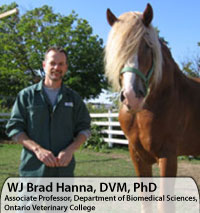 Hanna took everyone on a whirlwind journey through time which left the audience in no doubt of the need for best scientific practices and meticulously recorded statistics. Hanna explained, "The lesson of bloodletting is arguably the most important lesson in the history of medicine, yet it has been largely forgotten. This leaves us in the unenviable position of making the same mistakes, for the same reasons, and with the same unjustified sense of certainty in our beliefs, despite access to better information. Anyone who is genuinely interested in the well-being of their patients must take this lesson seriously." Hanna also reminded the participants that many modern pharmaceuticals originated from natural sources, citing an example of aspirin’s origin from the willow tree. By the end of his talk, listeners knew of many criteria to look for in valid studies. Hanna set the tone to keep an open mind but gave the audience some tools to assess credibility.
Hanna took everyone on a whirlwind journey through time which left the audience in no doubt of the need for best scientific practices and meticulously recorded statistics. Hanna explained, "The lesson of bloodletting is arguably the most important lesson in the history of medicine, yet it has been largely forgotten. This leaves us in the unenviable position of making the same mistakes, for the same reasons, and with the same unjustified sense of certainty in our beliefs, despite access to better information. Anyone who is genuinely interested in the well-being of their patients must take this lesson seriously." Hanna also reminded the participants that many modern pharmaceuticals originated from natural sources, citing an example of aspirin’s origin from the willow tree. By the end of his talk, listeners knew of many criteria to look for in valid studies. Hanna set the tone to keep an open mind but gave the audience some tools to assess credibility.
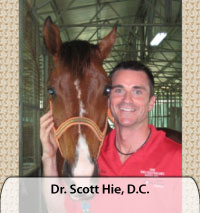 Bone cracking myths were dispelled as Dr. Scott Hie, D.C. Chiropractor, went on to educate the crowd about what an adjustment is, and when it is useful. Restriction and lack of motion were the symptoms Hie stated as reasons to see a Chiropractor? but not before seeing a vet. Hie laughs at some of the misunderstandings that often surround his practice and recommends, “If your horse has a bone out of place – call a surgeon!” Hie explained an adjustment as a high velocity, low amplitude thrust. The audience was encouraged to call their vets first and then seek out registered professionals from sites like www.veterinary chiropractic.ca. Hie reiterated the importance of teamwork between the vet, farrier, saddle fitter, massage therapist, nutritionist and chiropractor in addition to seeking out evidence-based knowledge. Feedback was resounding that more of this knowledge would be useful as listeners learned many of the examples of what not to do! Hie let everyone know chiropractic is not an option when there is severe heat, swelling, lameness or open wounds. Participants interested in learning more about how the joints are connected were encouraged to check out Equine Guelph’s Anatomy course or seminars.
Bone cracking myths were dispelled as Dr. Scott Hie, D.C. Chiropractor, went on to educate the crowd about what an adjustment is, and when it is useful. Restriction and lack of motion were the symptoms Hie stated as reasons to see a Chiropractor? but not before seeing a vet. Hie laughs at some of the misunderstandings that often surround his practice and recommends, “If your horse has a bone out of place – call a surgeon!” Hie explained an adjustment as a high velocity, low amplitude thrust. The audience was encouraged to call their vets first and then seek out registered professionals from sites like www.veterinary chiropractic.ca. Hie reiterated the importance of teamwork between the vet, farrier, saddle fitter, massage therapist, nutritionist and chiropractor in addition to seeking out evidence-based knowledge. Feedback was resounding that more of this knowledge would be useful as listeners learned many of the examples of what not to do! Hie let everyone know chiropractic is not an option when there is severe heat, swelling, lameness or open wounds. Participants interested in learning more about how the joints are connected were encouraged to check out Equine Guelph’s Anatomy course or seminars.
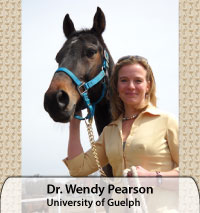 An exciting high level scientific talk ensued when Dr. Wendy Pearson of the University of Guelph took the stage, outlining the potential of a new breed of “super mint” to reduce inflammation and aid in the treatment of arthritis. The audience was shown the complexities of biochemistry through a vivid PowerPoint explaining how components within cells are interacting. The steps of Pearson’s intensive research using control groups and closely monitoring statistics were outlined in detail. Wendy’s enthusiasm and analogies helped everyone gain an appreciation of why best practices in scientific studies are so important in validating results. Equine Guelph director, Gayle Ecker, summed up this lecture stating, “If my chemistry professor was this passionate, I might be in a different field today.”
An exciting high level scientific talk ensued when Dr. Wendy Pearson of the University of Guelph took the stage, outlining the potential of a new breed of “super mint” to reduce inflammation and aid in the treatment of arthritis. The audience was shown the complexities of biochemistry through a vivid PowerPoint explaining how components within cells are interacting. The steps of Pearson’s intensive research using control groups and closely monitoring statistics were outlined in detail. Wendy’s enthusiasm and analogies helped everyone gain an appreciation of why best practices in scientific studies are so important in validating results. Equine Guelph director, Gayle Ecker, summed up this lecture stating, “If my chemistry professor was this passionate, I might be in a different field today.”
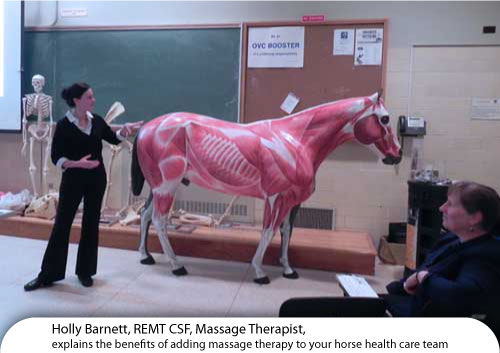
The search for symmetry followed with a hands-on talk by Holly Barnett, REMT CSF, massage therapist. With over 80 modalities of recognized massage, this speech left the audience wanting to learn more about trigger points and how to relieve those pesky knots. Everything from chronic tension to muscle spasms and rehabilitation were covered as reasons to employ a registered massage therapist (info can be found on sites like www.ifremt.org). Barnett also encouraged participants to utilize their health care team by seeking out the vet first and expanded upon the importance of a qualified saddle fitter as many muscular problems begin with incorrect saddle fit. Barnett instructed horse owners to “look for symmetry” and gave many tips on how to palpate and stretch horses to help combat what can become a vicious cycle of pain and muscle contraction.
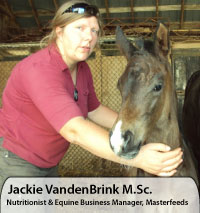 Lastly, and going into overtime, Jackie Vandenbrink, M.Sc. Equine Nutritionist, gave the audience food for thought. No one was concerned about staying late when Vandenbrink started serving up sound advice for feeding your herbivore a forage-based diet. Vandenbrink emphasized, “Good management should stimulate good digestion.” Over-supplementation was discussed and cautioned. Vandenbrink encourages horse owners to heed nutrient deficiencies and perform ration analysis. Often an imbalance in one nutrient is a sign of deficiencies elsewhere. Vandenbrink stressed the importance of looking at the whole picture and not reaching for one magical powder. If your vet/chiro/massage therapist finds a physical problem, talking to a nutritionist to improve your feed program can be an important part of the solution.
Lastly, and going into overtime, Jackie Vandenbrink, M.Sc. Equine Nutritionist, gave the audience food for thought. No one was concerned about staying late when Vandenbrink started serving up sound advice for feeding your herbivore a forage-based diet. Vandenbrink emphasized, “Good management should stimulate good digestion.” Over-supplementation was discussed and cautioned. Vandenbrink encourages horse owners to heed nutrient deficiencies and perform ration analysis. Often an imbalance in one nutrient is a sign of deficiencies elsewhere. Vandenbrink stressed the importance of looking at the whole picture and not reaching for one magical powder. If your vet/chiro/massage therapist finds a physical problem, talking to a nutritionist to improve your feed program can be an important part of the solution.
Good quality hay was discussed at length. Vandenbrink went on to inform the audience that hay is not a balanced diet and does not mimic grazing in the wild. Four-month-old hay does not contain the higher levels of Vitamin E that can be ingested on a well-maintained pasture. She suggests turning horses out on pasture as a great way to buffer the gut, guarding against ulcers. “A well functioning hind gut is a source of nutrients for the rest of the body not only in calories but also in B vitamins, electrolytes and fluids,” says Vandenbrink while discussing the importance of fibre. The participants were given plenty of information to digest. Feedback from the workshop, conclusively indicated horse owners are chomping at the bit for more of this valuable information.
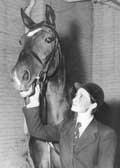 The evening of integrative therapies was made possible through a memorial contribution by family members of Rosalie Logan. This tribute honored a noted horsewoman and shared her love of the horse with other horse lovers. Rosalie believed an ounce of prevention was worth a pound of cure and Equine Guelph was pleased to facilitate this workshop. Equine Guelph thanks all attendees for their generous donations which help to develop future educational opportunities.
The evening of integrative therapies was made possible through a memorial contribution by family members of Rosalie Logan. This tribute honored a noted horsewoman and shared her love of the horse with other horse lovers. Rosalie believed an ounce of prevention was worth a pound of cure and Equine Guelph was pleased to facilitate this workshop. Equine Guelph thanks all attendees for their generous donations which help to develop future educational opportunities.